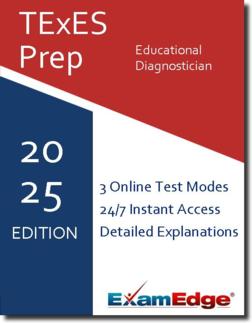TExES Educational Diagnostician (153) Practice Tests & Test Prep by Exam Edge - Topics
Based on 25 Reviews
- Real Exam Simulation: Timed questions and matching content build comfort for your TExES Educational Diagnostician test day.
- Instant, 24/7 Access: Web-based TExES Educational Diagnostician practice exams with no software needed.
- Clear Explanations: Step-by-step answers and explanations for your TExES exam to strengthen understanding.
- Boosted Confidence: Reduces anxiety and improves test-taking skills to ace your TExES Educational Diagnostician (153).

Understanding the exact breakdown of the TExES Educational Diagnostician test will help you know what to expect and how to most effectively prepare. The TExES Educational Diagnostician has 100 multiple-choice questions The exam will be broken down into the sections below:
| TExES Educational Diagnostician Exam Blueprint | ||
|---|---|---|
| Domain Name | % | Number of Questions |
| Students with Disabilities | 22% | 22 |
| Assessment and Evaluation | 33% | 33 |
| Curriculum and Instruction | 22% | 22 |
| Foundations and Professional Roles and Responsibilities | 22% | 22 |
| *Percentages do not add up to 100 due to rounding. | ||


